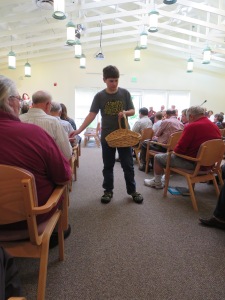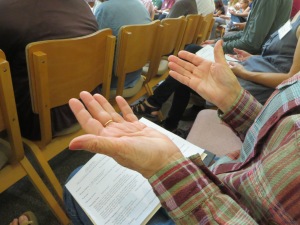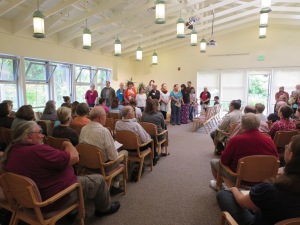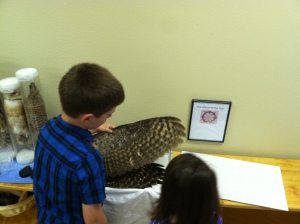For a PDF of this calendar so you can print it out: October 2015 calendar
Monthly Archives: September 2015
Dedicating the Teachers
Yesterday we launched another year in the Religious Education program of our congregation. And, although I certainly put a lot of prep and planning and work into what happened for our kids in their classes yesterday, the endeavor is far larger than any one person could do alone. In fact, it is far larger than even the team of teachers can do alone.
During our RE Dedication, we passed flower bulbs hand to hand among the congregation, blessing them as gifts for our teachers. We talked about how our young people need all of our hands: hands to maintain the building and grounds, hands to make the coffee and treats, hands to support the financial well-being of the church, hands to care for those in need, and hands to create a loving community. All of our hands are needed.
And then, we called forth our teachers. These are the wonderful folks who have chosen to give their time and presence to the creation of a program that lets children and youth grow in love, acceptance, and possibility. These are folks who don’t have all the answers, but are happy to explore the questions with you. These are folks who may still be struggling with questions of their own faith and belief, but know that that is OK. These are folks who are committed to anti-bias education, to welcoming all children and youth, and to the creation of a beloved community. These are some pretty special people, and yet they are just like you and me.
We called them forth and we gave them their charge and their blessing. I am so honored to start a new year off with these dear sweet people and our wonderful children and youth. I can’t wait to see what grows from it.
Animals of the Northwest Lesson Plans
If you would like a PDF you can print out:
Animals of the Pacific Northwest Lesson Plans
Animals of the Pacific Northwest Lesson Plans
Raptors
Materials Needed:
- “Birds” box from the Burke Museum
- Bean bag
- Photocopies of “My Bird Observations” from Burke lesson plan book
- Computer with internet access to show video
- CD player to play bird song CD
- The hawk call out of the bird box
Procedure:
- Light the Chalice
- Joys and Sorrows
- Welcome to the first lesson of Animals of the Pacific Northwest! As Unitarian Universalists, we lift up the importance of respecting the Interdependent Web of Life. Does anyone know which of our 7 Principles that is? (Answer: the 7th). This summer we are learning more about the animals that are part of our local interdependent web of life.
- Today’s animals are Raptors. We have a video to tell us what a raptor is:
- Raptor Hot Potato
- Sit in a circle, close enough to pass the beanbag hand to hand easily.
- Tell everyone that the beanbag makes you into a prey animal for a raptor. Ask for ideas of prey animals (salmon, fish, mice, smaller birds).
- In silence (because you’re trying not to get eaten!) pass the bean bag around until the sound of a raptor is played/or the bird call is used to make the sound of a hawk.
- As soon as that sound is heard, whoever is holding the beanbag gets eaten!
- Continue play until all but one child has been eaten, or until they are tired of it.
- Work Time Options:
- Bird Observations – be a scientist and use the resources here to make observations of one of the bird species we have here. Use the “My Bird Observations” form to work on this.
- Or on the art shelf we have feathers and supplies for making bird masks.
- We also have some books you can read, to learn more about raptors.
Taking It Home:
The class this Sunday focused on raptors. We watched this video, played a game of “Predator/Prey Hot Potato”, had bird specimens to observe, and made feather masks.
Extend the conversation at home:
- How do you feel about predators? What is their role in the interdependent web of life?
- Would you like to be able to fly? What do you imagine that feels like?
- Have you ever heard a hawk call? Seen a hawk?
- Why do you think the bald eagle was chosen as our national bird?
Act on it:
Go bird watching! The Nisqually Wildlife Refuge is a wonderful local place to see many birds.
Owls
Materials Needed:
- “Birds” box from the Burke Museum
- Photocopies of “My Bird Observations” from Burke lesson plan book
- Computer with internet access to show video
- CD player to play bird song CD
- Photocopies of “Can You Hear That?” from the Burke lesson plan book
Procedure:
- Light the Chalice
- Joys and Sorrows
- Welcome to the second lesson of Animals of the Pacific Northwest! As Unitarian Universalists, we lift up the importance of respecting the Interdependent Web of Life. Does anyone know which of our 7 Principles that is? (Answer: the 7th). This summer we are learning more about the animals that are part of our local interdependent web of life.
- Today we look at Owls – has anyone ever seen an Owl? Where and when? When are Owls active? (at night – they are nocturnal). They are also super quiet. Why would it be important to be super quiet if you hunt at night?
- We have a video to show us how quiet an owl is:
- https://youtu.be/6pWub12DUoU
- Another cool thing about Owls are Owl Pellets. What is an Owl Pellet? Here’s another video:
- https://youtu.be/JdrbSzC6Jcg
- Using Our Ears – Can You Hear That?
- Point out to the students that often we can hear a lot more birds than we can see. How many birds have they heard?
- Pass out the Can You Hear That? Worksheet
- Play the bird song CD and compare to the sounds printed on the sheet.
- Now flip the sheet over and the challenge is to write the sounds down that each student hears as you play the CD.
- Play one bird call at a time and everyone writes down what they heard.
- Work Time Options:
- Bird Observations – be a scientist and use the resources here to make observations of one of the bird species we have here. Use the “My Bird Observations” form to work on this.
- Work together to dissect an Owl Pellet.
- Or on the art shelf we have feathers and supplies for making bird masks.
- We also have some books you can read, to learn more about Owls.
Taking It Home:
The class this Sunday focused on owls. We watched these two videos, listened to a cd of bird calls and tried to think how to write them each out (ooohchtweet, etc.), had bird specimens to observe, and owl pellets to dissect.
Extend the conversation at home:
- How much do you rely on your eyes? How much on your ears?
- What can we hear in the world that we can’t always see?
- There are many animals that are nocturnal, and only come out at night. What do you think happens in your backyard while you sleep? What would it be like to be nocturnal?
Act on it:
Go bird watching! The Nisqually Wildlife Refuge is a wonderful local place to see many birds.
Deer, Elk, and Wolves
Materials Needed:
- The Mammals box from the Burke Museum
- Assorted library books about deer, elk, and wolves
- TV cart and computer for showing the video
Procedure:
- Light the Chalice
- Joys and Sorrows
- Welcome to another lesson of Animals of the Pacific Northwest! As Unitarian Universalists, we lift up the importance of respecting the Interdependent Web of Life. Does anyone know which of our 7 Principles that is? (Answer: the 7th). This summer we are learning more about the animals that are part of our local interdependent web of life.
- Today we’re talking about a few animals: deer, elk, and wolves. All of these animals are mammals, and some of them are prey while one is a predator. Does anyone know which is the predator?
- We’ll watch a video now about wolves: https://youtu.be/anwQaf_9DPE
- An active game: Predator/Prey tag
- Will need to do this either outside or in the large empty classroom.
- Put one or two kids in the center of the room. They are the wolves.
- Put all the other kids in a line on one side of the room. They are the deer/elk herd.
- When you say “go”, all the deer have to run across the room to the other side, while the wolves try to tag them. Anyone who gets tagged has to freeze.
- Now switch, and the kids who were frozen become the wolves while the kids who were wolves become deer and join the herd.
- Play until everyone has had a turn being a wolf.
- Work Time Options:
- Match a Mammal: work together to match the picture cards to the bones and the fur. Which specimen is from which species?
- Or use the materials on the art shelf to make art about wolves or deer.
- We also have some books you can read, to learn more about the animals.
Taking It Home:
The class this Sunday focused on Wolves. We watched this Video, played a game of Predator/Prey tag, and explored the specimens from the Burke Museum.
Extend the conversation at home:
- Wolves have had a bad reputation (think of the Big Bad Wolf). Why do you think that is?
- Why would people be afraid of wolves?
- How do you feel about predators? Why are they important to our interdependent web of life?
Act on it:
Visit Wolf Haven!
Squirrels
Materials Needed:
- The Mammals box from the Burke Museum
- Assorted library books about squirrels
- Small nut or other small object that fits in a hand
- TV cart and computer for showing the video
Procedure:
- Light the Chalice
- Joys and Sorrows
- Welcome to another lesson of Animals of the Pacific Northwest! As Unitarian Universalists, we lift up the importance of respecting the Interdependent Web of Life. Does anyone know which of our 7 Principles that is? (Answer: the 7th). This summer we are learning more about the animals that are part of our local interdependent web of life.
- Today we’re talking about a common animal you might see in your backyard: squirrels. We’ll watch a video now about squirrels: https://youtu.be/RCBfdUhrk80
- An active game: Nut, Nut, Who Has the Nut?
- This is an adaptation of the classic game “Button, Button, Who Has the Button?” https://en.wikipedia.org/wiki/Button,_button,_who%27s_got_the_button%3F
- Have all the kids stand in a circle with their hands out in front, palms making a cup.
- With the nut in your hand, go around the circle touching the hands of every child, and secretly dropping the nut into one child’s hands.
- Everyone closes their hands, and doesn’t show whether or not they got the nut.
- Each child takes a turn guessing who has the nut, if they guess right they become the next person to “hide” the nut.
- Continue for as many rounds as you like.
- Work Time Options:
- Match a Mammal: work together to match the picture cards to the bones and the fur. Which specimen is from which species?
- Or use the materials on the art shelf to make art about wolves or deer.
- We also have some books you can read, to learn more about the animals.
Taking It Home:
The class this Sunday focused on Squirrels. We watched this video, played a game of “Nut, Nut, Who Has the Nut?”, and explored the specimens from the Burke Museum.
Extend the conversation at home:
- Some animals have adapted to live closer to humans, like squirrels. How do you feel about these backyard animals as opposed to “wild” animals?
- What can you do to make your backyard better habitat for animals like squirrels and birds?
- Some animals are considered “pests” because they get into our trash or eat out of bird feeders, etc. Are these sort of animals more or less important in the interdependent web of life? Are they more or less deserving of inherent worth and dignity?
Act on it:
“Good Environmental Stewardship Begins in Your Own Backyard”. Consider making your backyard (no matter how small!) a Backyard Wildlife Sanctuary. Plenty of great resources here: http://wdfw.wa.gov/living/backyard/
Bats
Materials Needed:
- Bats box from the Burke Museum at the University of Washington
- Blindfold
- Small bell or a keychain (something tinkly sounding)
- Media Cart and computer to show video and do the video game
Procedure:
- Light the Chalice
- Joys and Sorrows
- Welcome to another lesson of Animals of the Pacific Northwest! As Unitarian Universalists, we lift up the importance of respecting the Interdependent Web of Life. Does anyone know which of our 7 Principles that is? (Answer: the 7th). This summer we are learning more about the animals that are part of our local interdependent web of life.
- Today we’re talking about a mammal that can fly. Does anyone have a guess what that animal is? (Bats!)
- We’ll watch a video about bats: https://youtu.be/P_tykwBvqZ0
- An active game: Where’s the Moth?
- Get the kids up and into a circle. Choose one child to be the “Bat”, and place them in the center with a blindfold over their eyes.
- Once the Bat is blindfolded, you will start passing the bell around the circle, trying to keep it quiet. The bat, meanwhile, is listening for the bell and pointing where they think it is
- When the bat successfully points to where the bell is, the child holding the bell now becomes the Bat.
- Continue as long as they are enjoying it, or until everyone has had a turn to be the Bat once.
- Work Time Options:
- Bat Observations: we have some bat specimens to look at and explore.
- We also have some books you can read, to learn more about Bats.
- Take turns to play a computer game about echolocation: http://www.bats4kids.org/echolocation_game_sc.swf
Taking it Home:
The class this Sunday focused on bats. We watched this video, played a game of “Listen”, and explored the specimens from the Burke Museum, books about Bats, and this online game about echolocation.
Extend the conversation at home:
- Bats are really important and amazing creatures, but they have a bad reputation. Why do you think we love some animals and fear or hate others?
- Bats are an amazing example of evolution. Their wings evolved out of mammal hands. What else do you find amazing about bats?
- How can we be better neighbors to all the animals in our interdependent web of life?
Act on it:
Learn more at Bat Conservation International, build or buy a back yard Bat Box, and/or look for local Bat Walks from Stream Team (Woodard Bay is a local bat habitat).
Whales
Materials Needed:
- Whales Box from the Burke Museum
- Media cart and laptop computer
Procedure:
- Light the Chalice
- Joys and Sorrows
- Welcome to another lesson of Animals of the Pacific Northwest! As Unitarian Universalists, we lift up the importance of respecting the Interdependent Web of Life. Does anyone know which of our 7 Principles that is? (Answer: the 7th). This summer we are learning more about the animals that are part of our local interdependent web of life.
- Today we’re talking about a mammal that lives in the ocean. Does anyone have a guess what that animal is? (whales!)
- We’ll watch a video about whales and their songs: https://youtu.be/-oYIK6Bg6co
- An active game: How Big is a Whale?
- You will need to do this in the hallway.
- Lay out the whale rope, from the Burke Box
- Have children lie down alongside the rope, one at a time
- How many children does it take to equal a whale?
- Just how big is a whale?
- Work Time Options:
- Observations: we have some specimens to look at and explore.
- We also have some books you can read, to learn more about whales.
- Take turns to play a computer game about whale migration: http://sanctuaries.noaa.gov/whales/main_page.html
Taking it Home:
The class this Sunday focused on whales. We watched this video, checked our length against that of a whale, and explored the specimens from the Burke Museum, books about whales, and this online game about whalel migration.
Extend the conversation at home:
- How does it make you feel to compare yourself to such a large animal? Would you want to swim with whales?
- Do you think animals like this should be kept in captivity? Why or why not?
- Why do you think the humpback whales sing?
Act on it:
Go Whale Watching, and learn more about whales and support their conservation through WWF or the WDC.
Salmon
Materials Needed:
- Media cart and laptop computer
- Beanbags
- Salmon (or trout) for fish prints
- Smoked salmon to eat
- Print outs of salmon coloring pages
Procedure:
- Light the Chalice
- Joys and Sorrows
- Welcome to another lesson of Animals of the Pacific Northwest! As Unitarian Universalists, we lift up the importance of respecting the Interdependent Web of Life. Does anyone know which of our 7 Principles that is? (Answer: the 7th). This summer we are learning more about the animals that are part of our local interdependent web of life.
- Today we’re talking about a fish that is very important to our local ecosystems and to our local cultures. Any guesses? (Salmon!)
- We’ll watch a video about them: https://youtu.be/5DqjsWsY8-g
- An active game: Swim Upstream (Adaptation of “Over, Under” classic beanbag game)
- You will need to do this in the hallway if you have many children.
- Have the children form a line, all facing the same direction.
- Starting at the front of the line, begin passing the beanbag, backwards.
- The first child passes it up and over their head, saying “Over”.
- The next would then pass it down and under between their legs, saying “Under”.
- This repeats, with the challenge being to go as fast as possible without dropping the bean bag or messing up the pattern.
- Start another bag going, until all the bags “Salmon” have gone upstream.
- Work Time Options:
- We also have some books you can read, to learn more about salmon.
- We have two different Salmon Coloring books you can put together.
- You can make a fish art print by painting on the fish and pressing a piece of paper on to make a print.
- We also have a little bit of smoked salmon you can taste if you eat fish.
Taking it Home:
The class this Sunday focused on Salmon. They watched this video, played a game together, and had a chance to taste some smoked salmon.
Extend the conversation at home:
- Salmon are very important to the culture of many of the native peoples of the northwest. Why do you think this animal is so important?
- How can we take care of the salmon? What should we do to save these species?
- Have you ever seen the salmon run? Do you like to eat salmon? How can we make sure our consumption (eating) is sustainable?
Act on it:
Get involved with Stream Team, with their impressive efforts in habitat restoration and preservation, and education.
The Interdependent Web of Life
Materials Needed:
- Ball of yarn
- Magazines to cut up (food, nature, gardening types)
- Scissors
- Glue
- paper
Procedure:
- Light the Chalice
- Joys and Sorrows
- Welcome to the last lesson of Animals of the Pacific Northwest! As Unitarian Universalists, we lift up the importance of respecting the Interdependent Web of Life. Does anyone know which of our 7 Principles that is? (Answer: the 7th). This summer we’ve learned about many different animals
- An active game: Make a Web
- Standing in a circle, have all the kids think of a plant or animal they could be
- While holding the yarn, say what you are and have anyone who could eat you or be eaten by you raise their hands. Throw the ball to one of them, while still holding on to your part of the yarn.
- Repeat, and each time the “web” will be getting more and more complicated.
- Once everyone is holding part of the web, have everyone pull back, shake, go slack, etc.
- Discuss how what happens to one part of the web affects everyone else in the web.
- Collages: use the magazines to make collages of each person’s web of life.
Taking it Home:
The class this Sunday was a wrap-up of our summer exploration of the interdependent web of life, with a yarn-web game and collage making of our own interdependent webs.
Extend the conversation at home:
- What plants and animals are in your interdependent web of life?
- How does something that happens to one part of the web affect the rest?
- How can we respect the interdependent web of life?
Act on it:
The ultimate “it affects us all” issue is climate change. Join in with our Unitarian Universalists addressing climate change at Commit2Respond: http://www.commit2respond.org/




